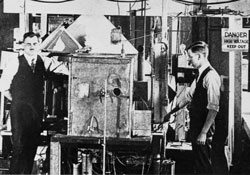Landmarks: Photons are Real
APS has put the entirePhysical Review archive online, back to 1893. Focus Landmarks feature important papers from the archive.
Does light consist of waves or particles? In the early 1920s physicists were still not certain. Albert Einstein’s description of particles or “quanta” of light–now called photons–had been around since 1905, but at the same time, over a century of experiments had confirmed that light behaves like water waves. In May 1923, Arthur Compton of Washington University in St. Louis almost single-handedly ended doubts about photons with his paper in the Physical Review. He aimed x rays and gamma rays at electrons and showed that they emerged from the collisions just as would be expected for minuscule billiard balls.
Previous experiments had provided only indirect support for the particle hypothesis. Compton reasoned that in a direct test, when a light quantum collides with a free electron, the two should scatter from the collision like billiard balls across a pool table. According to the conservation laws of energy and momentum, the incoming photon “ball” must lose some of its energy and momentum to the electron as the two bounce off each other. For the photon, these quantities are represented by the wavelength; for the electron, they are indicated by the speed of recoil from the collision. Using the conservation laws, Compton predicted the wavelengths of photons and speeds of electrons emerging at different angles from the collision.
Testing his predictions by bombarding lightly bound electrons in graphite, aluminum, and paraffin, with high-energy x rays and gamma rays, Compton found what he called “remarkable agreement between experiment and theory.” The data were inconsistent with the wave theory, which predicted that the scattered light would spread in all directions, like water waves radiating from a stone dropped in a pond.
For Arnold Sommerfeld, then at the University of Munich, Compton’s paper signified that “the wave theory of x rays will have to be given up.” Compton’s experiments represented a fundamental “turning point in physics,” says historian Roger Stuewer of the University of Minnesota in Minneapolis, author of a book on Compton’s work. In 1927 Compton received the Nobel Prize in physics for what is now called the Compton effect.
As for the wave theory, most physicists were happy to retain it for some phenomena, while simultaneously embracing the new photon hypothesis for others. But in 1924 Niels Bohr of Copenhagen University and co-workers–who were still uncomfortable with the photon concept–attempted to undercut the hypothesis with a new theory. They proposed that the laws of conservation of energy and momentum were not valid at the high level of precision Compton reached in his experiments.
All doubts and alternatives soon ceased, however, when researchers in Germany and the U.S., including Compton, experimentally refuted Bohr’s theory. Einstein summed up the situation in 1924: “We now have two theories of light, both indispensable, but, it must be admitted, without any logical connection between them, despite twenty years of colossal effort by theoretical physicists.” The quantum nature of light was clear, but the full quantum theory, which integrated both types of behavior, was still several years away.
–David C. Cassidy
David C. Cassidy is Professor of Natural Science at Hofstra University in Hempstead, New York.



